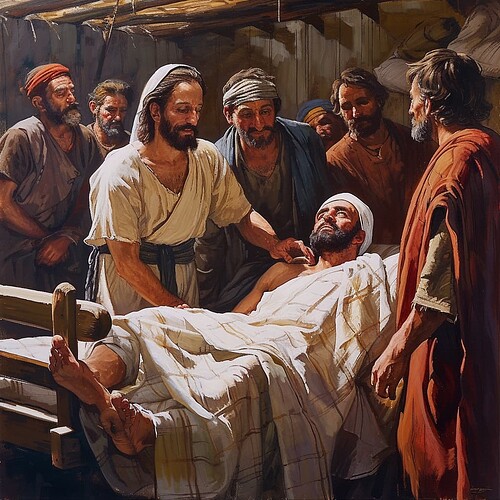 February 6: Mark 2 - A Display of Jesus’ Authority and Power
February 6: Mark 2 - A Display of Jesus’ Authority and Power
 Introduction
Introduction
In Mark 2, we witness several key events that showcase Jesus’ authority - over physical ailments, spiritual infirmities, ancient traditions, and societal norms. This chapter dramatically demonstrates how Jesus’ ways differ from societal expectations.
 Jesus Heals a Paralyzed Man
Jesus Heals a Paralyzed Man
In a public display of both compassion and power, Jesus heals a paralytic that had been lowered through the roof by friends - a testament to the power of faith and community support. ![]() Mark 2:5, “When Jesus saw their faith, he said to the paralyzed man, ‘Son, your sins are forgiven.’”
Mark 2:5, “When Jesus saw their faith, he said to the paralyzed man, ‘Son, your sins are forgiven.’”
 Jesus Dines with Sinners
Jesus Dines with Sinners
Next, we see Jesus eating at Levi’s house alongside tax collectors and sinners - a shocking occurrence in those times. Yet, He reminds us that He came to heal, not the healthy, but the sick - a message of Jesus’ unbound mercy. ![]() Mark 2:17, “…‘It is not the healthy who need a doctor, but the sick. I have not come to call the righteous, but sinners.’”
Mark 2:17, “…‘It is not the healthy who need a doctor, but the sick. I have not come to call the righteous, but sinners.’”
![]() Key Themes and Reflections
Key Themes and Reflections
- Jesus’ authority and power: From healing physical ailments to forgiving sins, Jesus shows His divine power and authority. He underlines the often-forgotten link between spiritual wellness and physical health.
- The need for a new way: Jesus’ criticism of rigidity and blind adherence to tradition calls us to reflect on our own understanding of faith, emphasizing the need for fresh wine in new wineskins - a metaphor for His transformative message.
![]() Today’s Application
Today’s Application
Today, we can emulate Jesus’ compassionate approach, by showing mercy to those who society often neglects. We can heed Jesus’ call to allow the transformative message of the Gospel to shape our lives, rather than clinging to convention and tradition.
![]() Hidden Gem
Hidden Gem
Did you notice how Jesus reacted to the faith of the paralyzed man’s friends, rather than the man himself? This highlights the power of intercessory prayer - our faith can manifest miracles for others.
![]() Reflective Q&A
Reflective Q&A
![]() How should we understand Jesus dines with sinners?
How should we understand Jesus dines with sinners?
A: We should view this as an act of radical inclusivity - conveying God’s expansive and all-encompassing mercy.
![]() What does the metaphor ‘new wineskins’ signify?
What does the metaphor ‘new wineskins’ signify?
A: ‘New wineskins’ signify the transformative power of the Gospel, which requires a new, flexible way of thinking rather than rigid, old structures.
![]() What does Jesus’ healing power reveal?
What does Jesus’ healing power reveal?
A: His healing power reveals both His divine authority and His deep compassion for human suffering.
![]() Join the Discussion
Join the Discussion
What stood out for you in today’s reading? How can you apply Jesus’ teachings in your life? Remember, every step towards Him is a step towards healing and transformation.
![]() See You Tomorrow in Mark 3
See You Tomorrow in Mark 3
As we continue our journey through Mark, Jesus’ divine power will continue to be revealed in exciting ways. Stay tuned, stay blessed!
